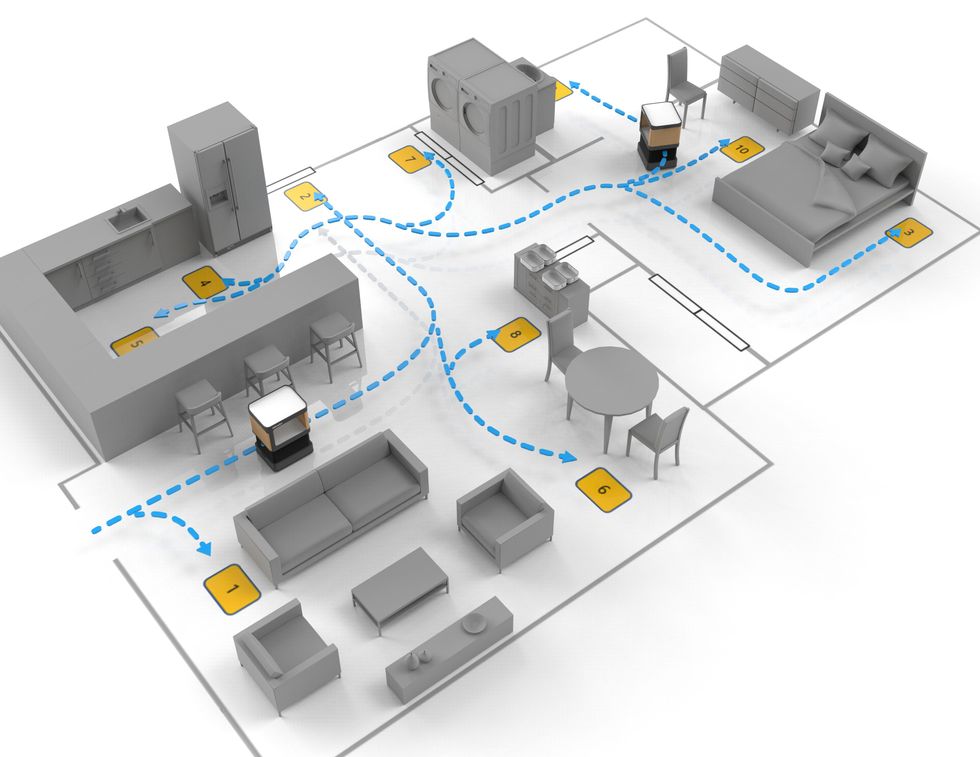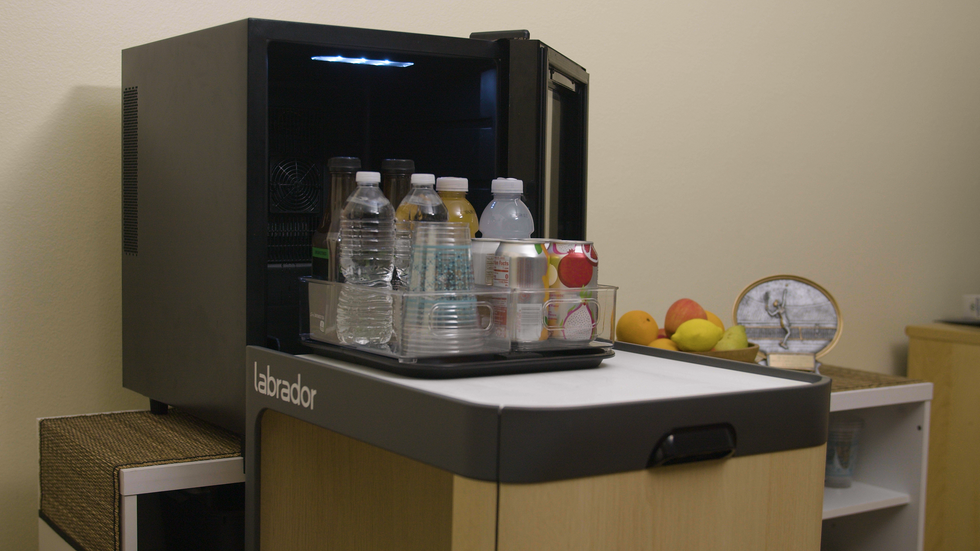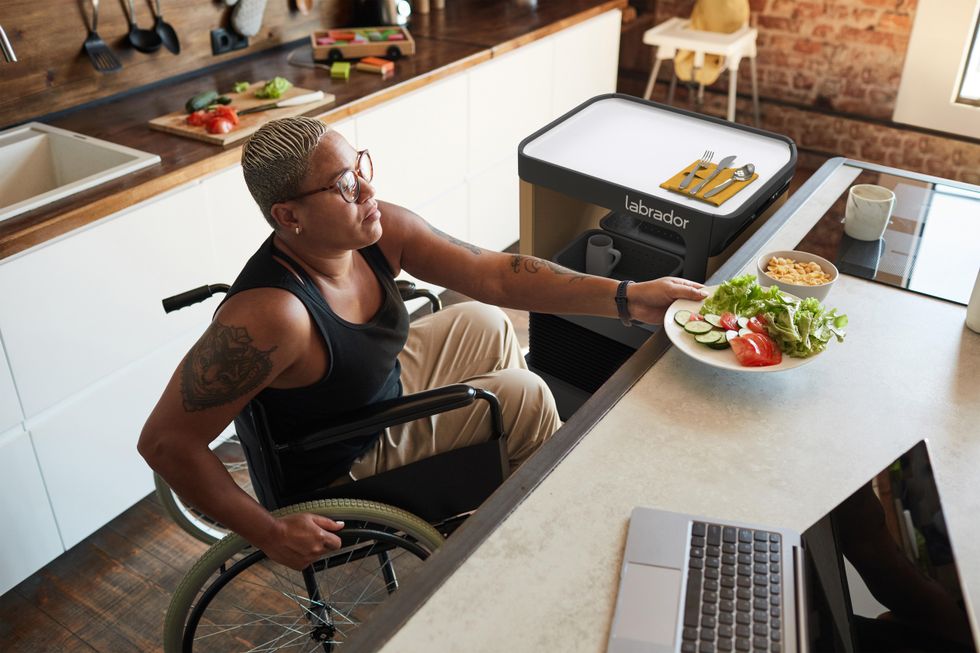It’s not often that we see a home robot that manages to be both relatively affordable and realistically technologically achievable while also solving a clear and widespread need. The iRobot Roomba was arguably the first good example of such a robot, but I’m hard pressed to think of what the second good example would be, which is why this new home robot from Labrador Systems is so exciting—it’s essentially a semi-autonomous mobile table, which is poised to have a huge impact on people who could really use exactly that.
If you’re not sure why anyone would need a semi-autonomous mobile table, then congratulations on likely being young enough and healthy enough that you aren’t currently experiencing significant mobility problems. But for many older adults as well as adults with disabilities, reliance on mobility aids (like canes or walkers) means that moving around while carrying things in hands or arms is difficult and dangerous, and for some, moving at all can be painful or exhausting. This can necessitate getting in-home help, or even having to leave your home completely, and this is the problem that Labrador wants to solve, or at least mitigate, with its mobile home robot.
When we spoke to Labrador cofounder Mike Dooley back in October of 2019, here’s how he described the (then still secret) robot that he was working on:
One of the core features of our robot is to help people move things where they have difficulty moving themselves, particularly in the home setting. That may sound trivial, but to someone who has impaired mobility, it can be a major daily challenge and negatively impact their life and health in a number of ways. Some examples we repeatedly hear are people not staying hydrated or taking their medication on time simply because there is a distance between where they are and the items they need. Once we have those base capabilities, i.e., the ability to navigate around a home and move things within it, then the robot becomes a platform for a wider variety of applications.
Two years later, this is the Labrador Retriever:
“Our robots are designed to serve as an extra pair of hands and lighten the load of everyday tasks in the home.” —Mike Dooley
The video above comes after several months of in-home testing of an alpha version of Labrador’s robot, which started back in February of 2021. “We saw usage rates as high as a hundred times a month,” Dooley told us. “All of the pilot users rated the robot highly, and two of them asked if they could invest in the company.” And honestly, I can totally understand why.
Despite its apparent simplicity, this is quite possibly the most exciting home robot I’ve seen in years, in the sense that it’s not just useful, but also needed. For people with limited mobility, the Labrador robot offers a place to store and transport heavy items that might be impossible for those people to carry or move on their own. Items that are used regularly, like water or books or medications or whatever, can live semi-permanently in the storage area in the middle deck of the robot, and in total the robot can handle up to 25 pounds (11 kilograms) of whatever you can fit on it. One version of the robot is at a fixed height, while a slightly more expensive version can raise and lower the height by about one-third of a meter and do some other clever stuff that we’ll get into in a moment.

Autonomy is fairly straightforward. Labrador uses 3D visual simultaneous localization and mapping, or SLAM, combined with depth sensors and bumpers on all sides to navigate through home environments, managing (we’re told) tight spaces, ADA-compliant floor transitions, and low lighting conditions, although you’ll have to keep clutter and cords away from the robot’s path and possibly tape down troublesome carpet edges. When you first get a robot, a Labrador representative will (remotely) drive it around to build a map and to set up the “bus stops” where the robot can be sent. This greatly simplifies control, since the end user can then just speak a destination into a smartphone app or a voice assistant and the robot will make its way there, zero training time required. The robot can also be scheduled to be at specific spots at specific times. All-day battery life is achievable since the robot spends most of its time being a table and not moving. And it’ll even charge the user’s small electronics on its lower deck.
A quick word on privacy, because this is a mobile robot with cameras on it that has access to your home. Dooley tells us that aside from the setup and troubleshooting, Labrador’s robots are intended to be fully autonomous, without a human in the loop. Having a remote-access capability is certainly useful, and it’s easy to see how family members might be interested in being able to leverage the robot in this way in an emergency. But, there’s really no good way of giving someone on-demand remote access while also making sure that the robot respects your privacy at all times. This isn’t a problem that’s unique to Labrador, but Dooley says that the company plans to add a hardware or software switch that can enable or disable remote connectivity, which seems like a reasonable compromise.
Of course, you can’t very well call a robot a “Retriever” if it doesn’t solve the problem of bringing things back to you without relying on a person on the other end to place those things onto the robot. I’ve lost count of the number of beer- (or whatever-) fetching robots that attempt to use manipulators to open a refrigerator and find and grasp something inside, which is a superhard problem that is years away from being solved in a practical in-home way. Labrador has quite cleverly side-stepped this problem through a minor amount of environmental modification, which is really the right way of going about introducing home robots right now.

Labrador has designed a system of pallets and trays that allow its Retriever robot to carry out fetching tasks autonomously. Pallets can be attached to tables or countertops, and then the robot can be instructed to interface with a specific pallet and retrieve the tray. It takes a little bit of forethought, since obviously the robot can only fetch what’s on the tray and nothing else, but with a minimal amount of affordable infrastructure, the amount and variety of stuff that Retriever can bring to you is significantly increased.
One use case that Labrador is actively developing is a pallet and tray that can work with a small refrigerator. This is going to take more significant hardware mods (like, a custom fridge that will presumably come with a significant added cost), but the idea is that a meal or two on a tray could be preloaded into the fridge, kept cold, and then requested at any time. You could also imagine a microwave modified to work in a similar way, so that meals could be heated on demand as well.

Before we get too caught up in add-ons like fridges and microwaves that aren’t yet available, let’s talk about the cost. Arguably the biggest challenge that Labrador has to face is not a technical one (although there are plenty of technical challenges to overcome with any mobile home robot), but rather an economic one: Users have to be able to afford it. This is a bit more complicated for Labrador in particular, since the robot is designed for people with disabilities or people who are likely retired or both, and who therefore may not have the kind of disposable income that’s usually associated with a mobile home robot. Labrador’s base model robot, called Caddie (which has a fixed height and is not compatible with the pallet/tray system), will cost US $1500 plus $100 per month for 36 months. Retriever, which does the clever tray stuff, goes for $150 per month; once the robot has been paid off, it’s all yours, although there will likely continue to be a (lower) monthly fee for support and new features. This is not an insignificant cost, but the context is critical here—rather than thinking of the cost in a vacuum, it’s important to consider what services Labrador’s robots are potentially replacing.
In-home care from humans is expensive. A disabled person might need help for only a couple hours a day, but the cost for that help could easily run into the hundreds of dollars per week. And even if they’re getting care from a human with whom they have a relationship, they’re not paying money for it, that care is still by no means free.
There’s a mental cost to always asking for help. If you’re in a situation where your spouse is your caregiver, it can be stressful for both individuals. And I think that’s why we get this super strong reaction of, “this really gives me some degree of independence back.” We’re not trying to replace a person with our robot, we’re just trying to give people the choice, especially for simple things, of whether they ask for help or not. —Mike Dooley
Consider also the cost of being restricted in what you can do by whether you have someone around to help you or not—like, imagine being only able to have lunch or do the laundry or even get a drink of water on someone else’s schedule. Labrador’s robots aren’t intended to replace the care of humans, but rather to extend the windows of time during which folks with mobility challenges can be safe and comfortable on their own. From that perspective, for many if not most users, Labrador’s robots will likely have no trouble paying for themselves in short order. Ideally, the relative difference in cost between a robot and in-home care from a professional human would provide an incentive for health care systems and insurance companies to provide subsidies, since it seems like it would improve care for members while lowering the overall cost. This hasn’t happened yet, but it’s something that Labrador is working on.

To its credit, Labrador is also being very, very careful about the rollout of its robots. The robot I was introduced to in secret at CES 2020 was very similar to this prerelease version announced at CES 2022, and Labrador has spent the intervening years making sure that it’s manufacturable, supportable, and can work reliably in a wide variety of homes. But it’s very much still a prerelease version. Labrador doesn’t expect to be in full production until the second half of 2023. The company is taking fully refundable $250 reservations now, though, and if you’re lucky (and live in the right place) you might be able to get access to a beta unit earlier than that. For the rest of us, 2023 does seem like a long time to wait, but it’ll be absolutely worth it if Labrador can get this right.
From Your Site Articles
Related Articles Around the Web
Credit: Source link




















